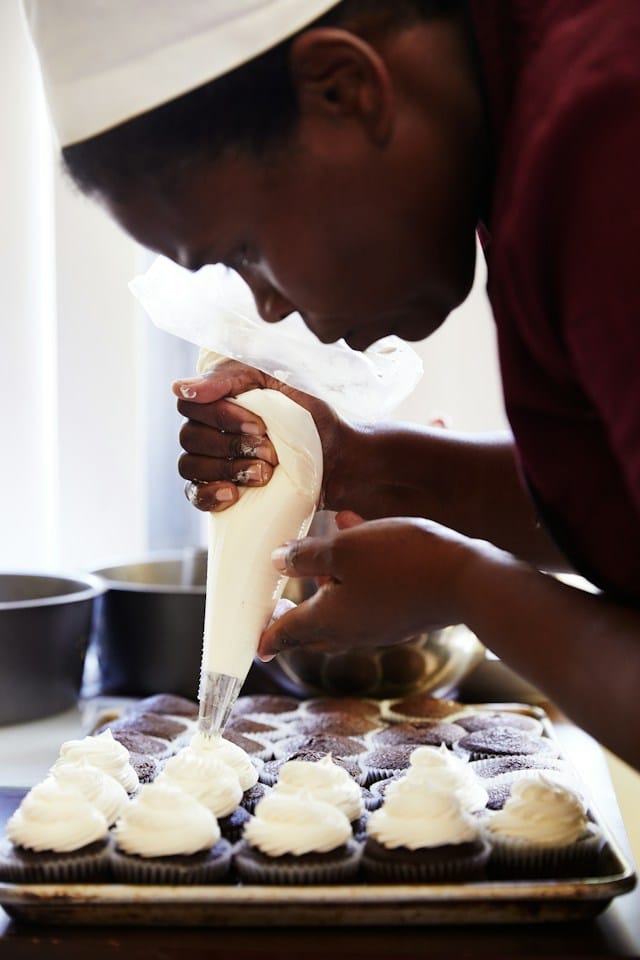To truly appreciate the magic of baking, one perfect example is the chiffon cake. This delightful cake is a feat of culinary engineering, known for its light, airy, and moist crumb. The hurdle that many baking enthusiasts face is achieving that perfect texture. So what’s the secret? It lies within the method and the ingredients, especially the egg whites. In this article, you’ll learn about the importance of egg whites, the role of the chiffon pan, and the technique behind the batter preparation.
Cracking the Code: The Importance of Egg Whites in Chiffon Cakes
Every successful chiffon cake starts with the correct handling of the eggs. The eggs, especially the whites, are vital in maintaining the cake’s structure and giving it the lightness that chiffon cakes are known for. You might be wondering, how do these humble egg whites achieve these?
Lire également : Can You Master the Technique of Cooking the Perfect Duck Breast at Home?
The answer lies in the process of whisking the egg whites. When you whisk egg whites, you introduce air into them. This air gets trapped within the structure of the egg whites, causing them to increase in volume – a process also known as whipping into a meringue. As the cake bakes, this trapped air expands with the heat, making the cake rise and resulting in a light, airy texture.
Another important point to remember when working with egg whites is to ensure they are free of any traces of yolk. Even a small amount of yolk can inhibit the egg whites from whipping up properly. Also, ensure your whisk and bowl are clean and dry as any oil or water can negatively affect the whisking process.
En parallèle : How to Create an Authentic Sichuan Meal with the Right Balance of Spices?
For an optimal outcome, it’s advisable to use a stand mixer or an electric hand whisk. This will ensure the egg whites are whipped into stiff peaks, which will hold their shape when you lift the whisk. A perfect meringue is glossy, smooth, and holds its shape well.
Choosing the Right Pan for Baking Chiffon Cakes
The type of pan you use for baking chiffon cakes is just as crucial as the ingredients and technique you employ. A chiffon cake pan, also known as an angel food cake pan, is typically a tube pan with a removable bottom. This design is not by chance but serves specific purposes in the baking process.
Firstly, the tube in the center of the pan allows heat to distribute evenly through the batter, resulting in an evenly baked cake. Secondly, the tube and the tall sides of the pan provide support for the cake as it rises, ensuring it maintains its height and structure.
Additionally, most chiffon cake pans are made of aluminum, which conducts heat well and promotes even baking. These pans are also typically uncoated, allowing the cake batter to ‘climb’ up the sides of the pan, which helps in achieving the maximum height.
Avoid using non-stick pans for baking chiffon cakes. The slick surface prevents the batter from adhering to the sides, which can inhibit the cake’s rise. Remember, a well-risen chiffon cake is key to achieving the desired lightness and airiness.
Mastering the Art of the Chiffon Cake Batter
The batter preparation process is another crucial aspect of baking the perfect light and airy chiffon cake. The batter’s consistency has a significant impact on the final texture and structure of the cake.
Firstly, when mixing your dry ingredients — typically flour, baking powder, and sugar — ensure they are well combined. This will help in achieving a uniform texture in your cake.
Next, when adding the oil, it should be incorporated slowly to avoid deflating the batter. The purpose of the oil is to moisten and tenderize the cake.
Then comes the step of adding the egg yolk mixture to the dry ingredients. This should be done gradually and mixed gently until everything is just combined. Overmixing at this stage can lead to a dense cake.
Finally, the whipped egg whites (meringue) are folded into the batter. This is perhaps the most crucial step in the batter preparation process. The egg whites should be folded gently and gradually to maintain their airiness. Any vigorous or hasty mixing at this stage can deflate the egg whites, resulting in a dense cake.
Bake and Wait: The Importance of Baking Time and Cooling
Once the batter is prepared and the pan is correctly chosen, it’s time to bake the chiffon cake. The baking time is crucial in achieving the perfect texture. Overbaking can result in a dry cake, while underbaking can cause the cake to fall or collapse.
As a general rule, a chiffon cake takes about 55 to 60 minutes to bake in a preheated oven at 325°F (165°C). However, this can vary depending on the exact size and type of your pan, as well as your specific oven.
After baking, cooling the chiffon cake is equally important. Due to its light and airy structure, a chiffon cake needs to be cooled upside down in its pan. This helps the cake maintain its height and prevents it from collapsing while it cools.
In conclusion, baking a light and airy chiffon cake isn’t all that complicated when you understand the techniques and ingredients involved. From correctly whisking the egg whites to choosing the right pan, preparing the batter, and baking, each step plays a crucial role. While it might seem like a lot to remember, with a bit of practice, you’ll be baking perfect chiffon cakes every time. Happy baking!
The Perfect Recipe: Steps to Follow in Baking Chiffon Cakes
Before you start baking a chiffon cake, it’s essential to have all the necessary ingredients on hand. The key ingredients for a chiffon cake typically include egg whites, egg yolks, sugar, cake flour, baking powder, vegetable oil, water, cream of tartar, and a flavoring agent like vanilla extract.
The first step is to separate the egg yolks from the egg whites. Remember to ensure that the egg whites remain free of any yolk traces. Then, mix the egg yolks, vegetable oil, water, and vanilla extract in one bowl. In another bowl, combine the cake flour, sugar, and baking powder.
Next, whisk the egg whites until frothy, then add cream of tartar. Continue whisking until stiff peaks form. Stiff peaks are characterized by egg whites that hold their shape firmly when the whisk is lifted.
The dry ingredients are then gradually added to the egg yolk mixture until the texture is uniform. Take care not to overmix the batter to prevent the cake from becoming dense.
The most delicate part of the process is incorporating the whipped egg whites into the batter. They should be folded gently and gradually to maintain their light and fluffy texture. Any rushed or vigorous mixing can deflate the egg whites and compromise the cake’s airiness.
Finally, pour the batter into the tube pan and smooth the surface with a spatula. Now it’s ready to bake!
Expert Tips for Perfect Chiffon Cakes
Following these expert tips can help ensure your success in baking light and airy chiffon cakes:
- Use fresh eggs. Fresh eggs tend to whip up more quickly and yield a higher volume of meringue.
- Use eggs at room temperature. Cold egg whites can take more time to whip and may not reach maximum volume.
- Add a pinch of cream of tartar to the egg whites. The acid in the cream of tartar helps stabilize the whipped egg whites and prevents them from deflating too quickly.
- Lastly, practice patience. Baking is a science and an art, and mastering chiffon cakes takes time and practice. Don’t be discouraged if your first few attempts don’t turn out as expected.
Conclusion
Mastering the art of baking chiffon cakes requires understanding the critical role each ingredient plays and the steps involved in the baking process. The secret lies in the whisking of the egg whites, choosing the right pan, the batter preparation, and the baking and cooling process.
Remember that patience is a key ingredient in baking. Don’t be discouraged if your first attempt doesn’t come out perfect. With practice, you will learn to tweak the process and ingredients to suit your own kitchen conditions and taste preferences.
Now that you know the secret to light and airy chiffon cakes, you’re ready to start baking. Let your culinary adventure begin!






